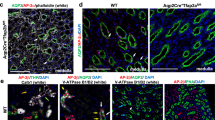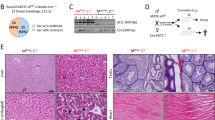Abstract
The Jun and JunB components of the AP-1 transcription factor are known to have antagonistic functions. Here we show, by a knock-in strategy and a transgenic complementation approach, that Junb can substitute for absence of Jun during mouse development. Junb can rescue both liver and cardiac defects in Jun-null mice in a manner dependent on gene dosage. JunB restores the expression of genes regulated by Jun/Fos, but not those regulated by Jun/ATF, thereby rescuing Jun-dependent defects in vivo as well as in primary fibroblasts and fetal hepatoblasts in vitro. Thus, the transcriptionally less active JunB has the potential to substitute for Jun, indicating that the spatial and temporal regulation of expression of the transcription factor AP-1 may be more important than the coding sequence of its components.
This is a preview of subscription content, access via your institution
Access options
Subscribe to this journal
Receive 12 print issues and online access
$209.00 per year
only $17.42 per issue
Buy this article
- Purchase on Springer Link
- Instant access to full article PDF
Prices may be subject to local taxes which are calculated during checkout






Similar content being viewed by others
References
Wagner, E.F. (ed.) AP-1. Oncogene 20, 2333–2498 (2001).
Jochum, W., Passegué, E. & Wagner, E.F. AP-1 in mouse development and tumorigenesis. Oncogene 20, 2401–2412 (2001).
Hilberg, F., Aguzzi, A., Howells, N. & Wagner, E.F. c-jun is essential for normal mouse development and hepatogenesis. Nature 365, 179–181 (1993).
Johnson, R.S., Van Lingen, B., Papaioannou, V.E. & Spiegelman, B.M. A null mutation at the c-jun locus causes embryonic lethality and retarded cell growth in culture. Genes Dev. 7, 1309–1317 (1993).
Eferl, R. et al. Functions of c-Jun in liver and heart development. J. Cell Biol. 145, 1049–1061 (1999).
Schorpp-Kistner, M., Wang, Z.-Q., Angel, P. & Wagner, E.F. JunB is essential for mammalian placentation. EMBO J. 18, 934–948 (1999).
Grigoriadis, A.E., Schellander, K., Wang, Z.Q. & Wagner, E.F. Osteoblasts are target cells for transformation in c-fos transgenic mice. J. Cell Biol. 122, 685–701 (1993).
Schorpp, M. et al. The human ubiquitin C promoter directs high ubiquitous expression of transgenes in mice. Nucleic Acids Res. 24, 1787–1788 (1996).
Li, B., Tournier, C., Davis, R.J. & Flavell, R.A. Regulation of IL-4 expression by the transcription factor JunB during T helper cell differentiation. EMBO J. 18, 420–432 (1999).
Mechta-Grigoriou, F., Gerald, D. & Yaniv, M. The mammalian Jun proteins: redundancy and specificity. Oncogene 20, 2378–2389 (2001).
Kockel, L., Homsy, J.G. & Bohmann, D. Drosophila AP-1: lessons from an invertebrate. Oncogene 20, 2347–2364 (2001).
Deng, T. & Karin, M. Jun B differs from c-Jun in its DNA-binding and dimerization domains, and represses c-Jun by formation of inactive heterodimers. Genes Dev. 7, 479–490 (1993).
Chiu, R., Angel, P. & Karin, M. Jun-B differs in its biological properties from, and is a negative regulator of, c-Jun. Cell 59, 979–986 (1989).
Hsu, J.C., Cressman, D.E. & Taub, R. Promoter-specific transactivation and inhibition mediated by JunB. Cancer Res. 53, 3789–3794 (1993).
Passegué, E., Jochum, W., Schorpp-Kistner, M., Möhle-Steinlein, U. & Wagner, E.F. Chronic myeloid leukemia with increased granulocyte progenitors in mice lacking JunB expression in the myeloid lineage. Cell 104, 21–32 (2001).
Dérijard, B. et al. JNK1: a protein kinase stimulated by UV light and Ha-Ras that binds and phosphorylates the c-Jun activation domain. Cell 76, 1025–1037 (1994).
Chang, L. & Karin, M. Mammalian MAP kinase signalling cascades. Nature 410, 37–40 (2001).
Gupta, S. et al. Selective interaction of JNK protein kinase isoforms with transcription factors. EMBO J. 15, 2760–2770 (1996).
Benbrook, D.M. & Jones, N.C. Heterodimer formation between CREB and Jun proteins. Oncogene 5, 295–302 (1991).
van Dam, H. & Castelazzi, M. Distinct roles of Jun:Fos and Jun:ATF dimers in oncogenesis. Oncogene 20, 2453–2464 (2001).
Schreiber, M. et al. Control of cell cycle progression by c-Jun is p53 dependent. Genes Dev. 13, 607–619 (1999).
Shaulian, E. et al. The mammalian UV response: c-Jun induction is required for exit from p53-imposed growth arrest. Cell 103, 897–907 (2000).
Bakiri, L., Lallemand, D., Bossy-Wetzel, E. & Yaniv, M. Cell cycle-dependent variations in c-Jun and JunB phosphorylation: a role in the control of cyclin D1 expression. EMBO J. 19, 2056–2068 (2000).
Wisdom, R., Johnson, R.S. & Moore, C. C-Jun regulates cell cycle progression and apoptosis by distinct mechanisms. EMBO J. 18, 188–197 (1999).
Passegué, E. & Wagner, E.F. JunB suppresses cell proliferation by transcriptional activation of p16INK4a expression. EMBO J. 19, 2969–2979 (2000).
Szabowski, A. et al. c-Jun and JunB antagonistically control cytokine-regulated mesenchymal-epidermal interaction in skin. Cell 103, 745–755 (2000).
Behrens, A., Sibilia, M. & Wagner, E.F. Amino-terminal phosphorylation of c-Jun regulates stress-induced apoptosis and cellular proliferation. Nature Genet. 21, 326–329 (1999).
Srivastava, D. & Olson, E.N. A genetic blueprint for cardiac development. Nature 407, 221–226 (2000).
van Dam, H. et al. Autocrine growth and anchorage independence: two complementing Jun-controlled genetic programs of cellular transformation. Genes Dev. 12, 1227–1239 (1998).
Bergers, G., Graninger, P., Braselmann, S., Wrighton, C. & Busslinger, M. Transcriptional activation of the fra-1 gene by AP-1 is mediated by regulatory sequences in the first intron. Mol. Cell. Biol. 15, 3748–3758 (1995).
Cirillo, G. et al. Role of distinct mitogen-activated protein kinase pathways and cooperation between Ets-2, ATF-2, and Jun family members in human urokinase-type plasminogen activator gene induction by interleukin-1 and tetradecanoyl phorbol acetate. Mol. Cell. Biol. 9, 6240–6252 (1999).
Fleischmann, A. et al. Fra-1 replaces c-Fos-dependent functions in mice. Genes Dev. 14, 2695–2700 (2000).
Kitabayashi, I. et al. Two cis-regulatory elements that mediate different signaling pathways for serum-dependent activation of the JunB gene. J. Biol. Chem. 268, 14482–14489 (1993).
Kolbus, A. et al. c-Jun-dependent CD95-L expression is a rate-limiting step in the induction of apoptosis by alkylating agents. Mol. Cell. Biol. 20, 575–582 (2000).
Brewer, J.W, Hendershot, L.M, Sherr, C.J. & Diehl, J.A. Mammalian unfolded protein response inhibits cyclin D1 translation and cell-cycle progression. Proc. Natl Acad. Sci. USA 96, 8505–8510 (1999).
Hashemolhosseini, S. et al. Rapamycin inhibition of the G1 to S transition is mediated by effects on cyclin D1 mRNA and protein stability. J. Biol. Chem. 273, 14424–14429 (1998).
Lin, S. et al. Down-regulation of cyclin D1 expression by prostaglandin A2 is mediated by enhanced cyclin D1 mRNA turnover. Mol. Cell. Biol. 20, 7903–7913 (2000).
Joyce, D. et al. NF-κB and cell-cycle regulation: the cyclin connection. Cytokine Growth Factor Rev. 12, 73–90 (2001).
Jacks, T. et al. Tumor spectrum analysis in p53-mutant mice. Curr. Biol. 4, 1–7 (1994).
Deng, C., Zhang, P., Harper, J.W., Elledge, S.J. & Leder, P. Mice lacking p21CIP1/WAF1 undergo normal development, but are defective in G1 checkpoint control. Cell 82, 675–684 (1995).
Matsuo, K. et al. Fosl1 is a transcriptional target of c-Fos during osteoclast differentiation. Nature Genet. 24, 184–187 (2000).
Acknowledgements
We are grateful to H.C. Theuβl for ES cell injections; to M. Yaniv (Pasteur Institute, Paris) for the JunB monoclonal antibody; to M. Oren for the p53 promoter construct; to R. Müller for the cyclin D1 promoter construct; to H. vanDam for the 5xJun2–luc reporter; and to M.-H. Idarraga-Amado and D. Mayr for maintaining our mouse colonies. We thank M. Bouchard, H. van Dam, M. Karin, M. Schreiber and M. Sibilia for critically reading the manuscript, and members of the Wagner laboratory for stimulating discussions and assistance. The Institute of Molecular Pathology is supported by Boehringer-Ingelheim, and this work was partly funded by the Austrian Research Foundation, by a TMR network grant from the European Economic Community and by a Marie Curie Fellowship from the European Community to W.J.
Author information
Authors and Affiliations
Corresponding author
Rights and permissions
About this article
Cite this article
Passegué, E., Jochum, W., Behrens, A. et al. JunB can substitute for Jun in mouse development and cell proliferation. Nat Genet 30, 158–166 (2002). https://doi.org/10.1038/ng790
Received:
Accepted:
Published:
Issue Date:
DOI: https://doi.org/10.1038/ng790
This article is cited by
-
IKAROS and AIOLOS directly regulate AP-1 transcriptional complexes and are essential for NK cell development
Nature Immunology (2024)
-
Vascular cell-adhesion molecule 1 (VCAM-1) regulates JunB-mediated IL-8/CXCL1 expression and pathological neovascularization
Communications Biology (2023)
-
New roles for AP-1/JUNB in cell cycle control and tumorigenic cell invasion via regulation of cyclin E1 and TGF-β2
Genome Biology (2022)
-
Mechanisms of Quercetin against atrial fibrillation explored by network pharmacology combined with molecular docking and experimental validation
Scientific Reports (2022)
-
The AP-1 transcription factors c-Jun and JunB are essential for CD8α conventional dendritic cell identity
Cell Death & Differentiation (2021)



